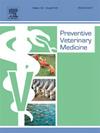Exploring the role of animal welfare in cow performance and farm profitability in Italian dairy herds
IF 2.4
2区 农林科学
Q1 VETERINARY SCIENCES
引用次数: 0
Abstract
Good welfare supports dairy herd health, enhances milk production and quality, and offers financial incentives for farmers committed to animal welfare. In Italy, the ClassyFarm system assesses dairy herd welfare through the evaluation of farm biosecurity, management, structures, and animal-based measures. Dairy farms with loose housing systems (LHS) and tied housing systems (THS) are evaluated using distinct ClassyFarm checklists, and an algorithm generates an overall welfare score ranging from 0 % (poor welfare) to 100 % (excellent welfare). Analysing 434 farms of Holstein and Simmental cows in north-eastern Italy, we explored whether housing systems (LHS and THS) and breed composition (single- vs. multi-breed herds) influence welfare scores as assessed by ClassyFarm. Additionally, we investigated whether milk quality and production differ in cows exposed to different welfare levels, considering 4 subsets: Holstein in LHS, Holstein in THS, Simmental in LHS, and Simmental in THS. Holstein single-breed herds achieved higher management (82.10 ± 1.78 %) and biosecurity scores (58.50 ± 2.44 %). Simmental single-breed herds scored highest in animal-based measures (87.90 ± 1.61 %), while multi-breed herds generally obtained lower scores than single-breed farms. Herds with higher management and biosecurity scores were associated with greater milk yield, milk quality, and economic returns, indicating that farmers who prioritize high welfare standards for their dairy herds may improve overall farm profitability. Our findings confirm the direct importance of investing resources in dairy cows’ welfare.
探索动物福利在意大利奶牛生产性能和农场盈利能力中的作用
良好的福利有助于奶牛群的健康,提高牛奶产量和质量,并为致力于动物福利的农民提供财政激励。在意大利,ClassyFarm系统通过对农场生物安全、管理、结构和基于动物的措施的评估来评估奶牛群的福利。使用不同的classsyfarm清单对松散住房系统(LHS)和捆绑住房系统(THS)的奶牛场进行评估,并通过算法生成从0 %(福利差)到100 %(福利优)的整体福利评分。我们分析了意大利东北部的434个荷斯坦奶牛和西门塔尔奶牛的农场,探讨了猪舍系统(LHS和THS)和品种构成(单品种与多品种牛群)是否会影响ClassyFarm评估的福利得分。此外,我们研究了暴露于不同福利水平的奶牛的牛奶质量和产量是否存在差异,考虑了4个子集:LHS中的荷斯坦奶牛、THS中的荷斯坦奶牛、LHS中的西门塔尔奶牛和THS中的西门塔尔奶牛。荷斯坦单种畜群的管理得分(82.10 ± 1.78 %)和生物安全得分(58.50 ± 2.44 %)较高。Simmental单品种畜群在动物性指标中得分最高(87.90 ± 1.61 %),而多品种畜群得分普遍低于单品种畜群。管理和生物安全得分较高的牛群与更高的产奶量、牛奶质量和经济回报相关,这表明优先考虑奶牛群高福利标准的农民可能会提高农场的整体盈利能力。我们的研究结果证实了在奶牛福利方面投入资源的直接重要性。
本文章由计算机程序翻译,如有差异,请以英文原文为准。
求助全文
约1分钟内获得全文
求助全文
来源期刊

Preventive veterinary medicine
农林科学-兽医学
CiteScore
5.60
自引率
7.70%
发文量
184
审稿时长
3 months
期刊介绍:
Preventive Veterinary Medicine is one of the leading international resources for scientific reports on animal health programs and preventive veterinary medicine. The journal follows the guidelines for standardizing and strengthening the reporting of biomedical research which are available from the CONSORT, MOOSE, PRISMA, REFLECT, STARD, and STROBE statements. The journal focuses on:
Epidemiology of health events relevant to domestic and wild animals;
Economic impacts of epidemic and endemic animal and zoonotic diseases;
Latest methods and approaches in veterinary epidemiology;
Disease and infection control or eradication measures;
The "One Health" concept and the relationships between veterinary medicine, human health, animal-production systems, and the environment;
Development of new techniques in surveillance systems and diagnosis;
Evaluation and control of diseases in animal populations.
 求助内容:
求助内容: 应助结果提醒方式:
应助结果提醒方式:


